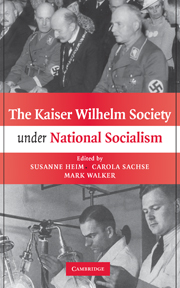Book contents
- Frontmatter
- Contents
- Tables
- Illustrations
- Editors
- Contributors
- Abbreviations
- Archives
- 1 The Kaiser Wilhelm Society under National Socialism
- SECTION I RESEARCH AND PERSONNEL POLICIES
- SECTION II RACIAL RESEARCH
- SECTION III EASTERN RESEARCH, LIVING SPACE, BREEDING RESEARCH
- SECTION IV MILITARY RESEARCH
- 11 Ideology, Armaments, and Resources: The Kaiser Wilhelm Institute for Metal Research and the “German Metals,” 1933–1945
- 12 Calculation, Measurement, and Leadership: War Research at the Kaiser Wilhelm Institute for Fluid Dynamics, 1937–1945
- 13 Chemical Weapons Research in National Socialism: The Collaboration of the Kaiser Wilhelm Institutes with the Military and Industry
- 14 Nuclear Weapons and Reactor Research at the Kaiser Wilhelm Institute for Physics
- SECTION V THE POSTWAR “POLITICS OF THE PAST”
- Bibliography
- Index
13 - Chemical Weapons Research in National Socialism: The Collaboration of the Kaiser Wilhelm Institutes with the Military and Industry
Published online by Cambridge University Press: 29 July 2009
- Frontmatter
- Contents
- Tables
- Illustrations
- Editors
- Contributors
- Abbreviations
- Archives
- 1 The Kaiser Wilhelm Society under National Socialism
- SECTION I RESEARCH AND PERSONNEL POLICIES
- SECTION II RACIAL RESEARCH
- SECTION III EASTERN RESEARCH, LIVING SPACE, BREEDING RESEARCH
- SECTION IV MILITARY RESEARCH
- 11 Ideology, Armaments, and Resources: The Kaiser Wilhelm Institute for Metal Research and the “German Metals,” 1933–1945
- 12 Calculation, Measurement, and Leadership: War Research at the Kaiser Wilhelm Institute for Fluid Dynamics, 1937–1945
- 13 Chemical Weapons Research in National Socialism: The Collaboration of the Kaiser Wilhelm Institutes with the Military and Industry
- 14 Nuclear Weapons and Reactor Research at the Kaiser Wilhelm Institute for Physics
- SECTION V THE POSTWAR “POLITICS OF THE PAST”
- Bibliography
- Index
Summary
The development of chemical weapons in World War I is closely associated with the name of the Kaiser Wilhelm Society (Kaiser-Wilhelm-Gesellschaft, KWS). Chemical weapons of mass destruction were researched and developed in the laboratories of the Kaiser Wilhelm Institute for Physical Chemistry and Electrochemistry (KWI für physikalische Chemie und Elektrochemie, KWIPC) under the direction of Fritz Haber, and deployed by the German empire for the first time in Ypers in April 1915. A number of comprehensive studies have examined the history of the research, development, and deployment of chemical weapons in World War I. In contrast, very little is known about their further development during National Socialism at institutes of the KWS, the largest research organization in Germany outside of the universities. Military historians have asked why no chemical weapons were deployed in Europe during World War II. The production of chemical weapons has also been studied from the perspective of economic history. Yet, for a long time there was no comprehensive investigation into the research on chemical weapons in the Nazi regime. The following remarks are based on a study of all research projects at the Kaiser Wilhelm Institutes conducted during National Socialism on both developing chemical weapons and providing the protection against them required for their military implementation.
Of the over forty institutes and research facilities of the KWS that existed during the National Socialist period, seven institutes were involved in research on chemical weapons and defending against them.
- Type
- Chapter
- Information
- The Kaiser Wilhelm Society under National Socialism , pp. 312 - 338Publisher: Cambridge University PressPrint publication year: 2009
- 1
- Cited by

